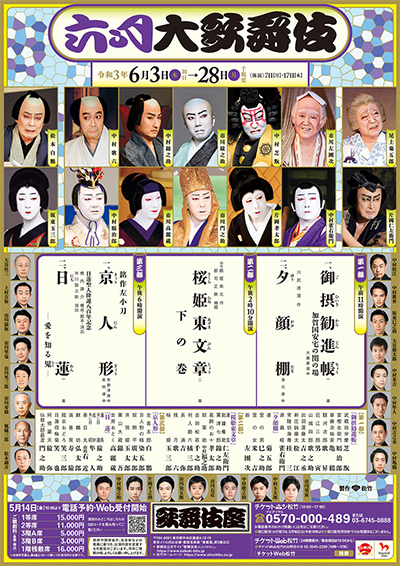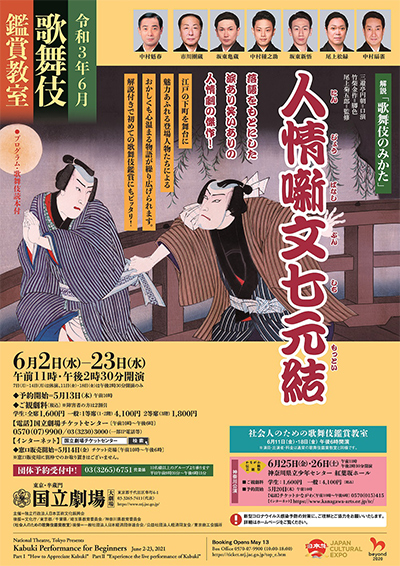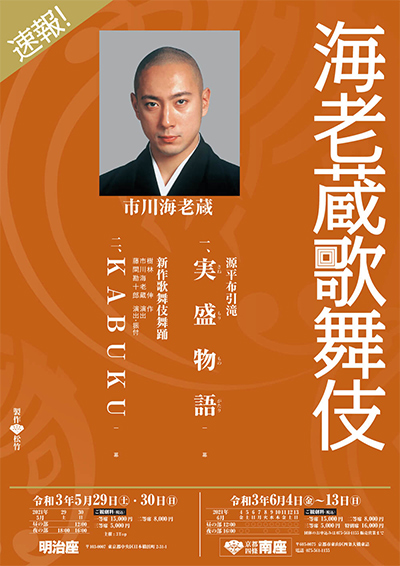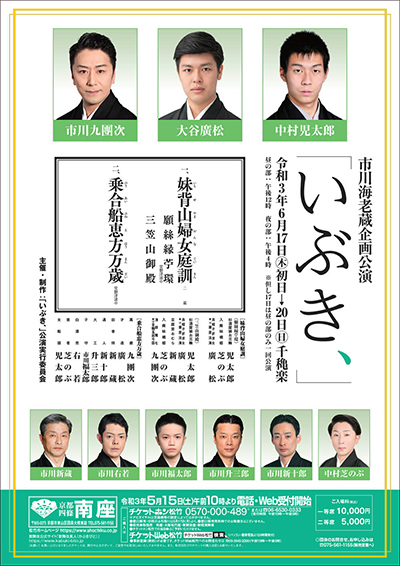| Dates |
3 ~ 28 June 2021
Rokugatsu ďkabuki
June Grand Kabuki |
| 1st program |
Gohiiki Kanjinch˘ (Ataka no Seki)
Yűgao Dana
|
| 2nd program |
Sakura Hime Azuma Bunsh˘
The second half of this drama only
|
| 3rd program |
Meisaku Hidari Kogatana (Ky˘ Ningy˘)
Nichiren
|
| Casting |
Living National Treasure Onoe Kikugor˘, Living National Treasure Kataoka Nizaemon, Living National Treasure Band˘ Tamasabur˘, Matsumoto Haku˘, Nakamura Shikan, Nakamura Jakuemon, Nakamura Ganjir˘, Ichikawa Ennosuke, Nakamura Kinnosuke, Kataoka Takatar˘, Ichikawa Sadanji, Nakamura Karoku,
Band˘ Minosuke, Nakamura Hayato, Nakamura Kikaku, Ichikawa Komaz˘, Ichikawa Monnosuke, Ichikawa Emisabur˘, Ichikawa Emiya, Ichikawa Juen, Ichikawa En'ya, Nakamura Matsue, Kamimura Kichiya, Matsumoto Kingo, ďtani Keiz˘,
ďtani Hirotar˘, Ichikawa Somegor˘, Nakamura Yonekichi, Nakamura Kash˘, Ichikawa Otora, Nakamura Fukunosuke, Nakamura Utanosuke, Kataoka Sennosuke, Nakamura Tamatar˘, Nakamura Kichinoj˘, Ichikawa Ukon
|
| Comments |
The 3 programs for the June Grand Kabuki at the Kabukiza.
Ataka no Seki: "Gohiiki Kanjinch˘" was first performed in 1773 and is most famous for its comic
aragoto version of the famous play "Kanjinch˘"
(The Subscription List). As they are fleeing, the powerful warrior priest Benkei (Nakamura Shikan)
gets his master Yoshitsune (Nakamura Jakuemon) through the barrier by pretending to be very weak and allowing himself to be
tied up. He cries like a baby when he is tormented by the barrier attendants.
But when Benkei decides that his master is safe, he explodes with energy,
showing off the bombastic aragoto style of acting.
He breaks the ropes and pulls off the heads of the attendants, tossing them into a barrel and washing them
like a bunch of potatoes. Featuring also Nakamura Ganjir˘ as Togashi no Saemon.
Yűgao Dana: this modern Kabuki dance was inspired by a traditional screen painting and was first performed
by Ichikawa Ennosuke II. As an elderly husband and wife sit at the veranda
enjoying the summer evening breeze, they meet a young couple going to the local folk dance.
The couple reminds them of their younger days and, though not quite as graceful,
they perform a light-hearted dance as they reminisce about their earlier days.
Starring Living National Treasure Onoe Kikugor˘ and Ichikawa Sadanji as the old woman and the old man.
Sakura Hime: unable to give up his attachment to Princess Sakura (Living National Treasure Band˘ Tamasabur˘), Seigen (Living National Treasure Kataoka Nizaemon) stays at the hermitage where
Zangetsu (Nakamura Karoku) and Nagaura (Kamimura Kichiya) live, but he is murdered by them. Gonsuke (Living National Treasure Kataoka Nizaemon) is asked to settle the matter, after which he meets Princess Sakura
again and they marry. Struck by a lightning bolt, Seigen revives and clings to Princess Sakura, but he finally dies. Princess Sakura gets the
nickname 'Princess Wind Chime' and becomes a popular prostitute. However, she is brought back to Gonsuke because a ghost appears by her
pillow every night. She also learns from the secret letter Gonsuke drops that he is the murderer of her father and her brother...
Featuring also Nakamura Kinnosuke and Kataoka Takatar˘.
Ky˘ Ningy˘: this dance tells the story of the woodcarver Hidari Jingor˘,
famous for the sleeping cat on the great gate of Nikk˘. He brings a statue of a
beautiful courtesan to life and then there is a spectacular fight scene with a
variety of carpenterĺs tools. Starring Matsumoto Haku˘ as Jingor˘ and Ichikawa Somegor˘ as the doll
of the courtesan.
Nichiren: this play is set in the 13th century, a time of great turbulence caused by raging wars,
a series of natural disasters, starvation and epidemics. In the depths of night on Mount Hiei, ascetic monks gather in front
of the main temple hall. Inside, Rench˘ has remained confined for ten days without eating or drinking, and now his voice chanting
the sutras can no longer be heard. In contrast to the other monks who are repulsed by Rench˘'s uncompromising attitude, J˘ben is moved
by Rench˘ĺs passion and is now concerned about him. J˘ben breaks down the door to enter the hall.
This Kabuki production commemorates the 800th anniversary of the birth of the famous Buddhist priest Nichiren.
Starring Ichikawa Ennosuke in the role of Rench˘ (later Nichiren).
Featuring also Nakamura Hayato in the role of J˘ben (later Nissh˘).
Sources: Sh˘chiku Kabuki Official Website
|
| Hakataza (Fukuoka) |
 |
|
| Dates |
5 ~ 19 June 2021
Rokugatsu Hakataza ďkabuki
June Hakataza Grand Kabuki |
| MatinÚe |
Matsu no Hagoromo
Yowa Nasake Ukina no Yokogushi (Kirare Yosa)
Misome
Genjidana
|
| Evening |
Keisei Hangonk˘ (Domo Mata)
Migawari Zazen
|
| Casting |
Nakamura Tokiz˘, Onoe Kikunosuke, Nakamura Baigyoku, Kawarasaki Gonjűr˘, Band˘ Hikosabur˘, Nakamura Baishi, Nakamura Mantar˘, Nakamura Kangyoku, Nakamura Baika
|
| Comments |
The traditional two programs for the June Grand Kabuki at the Hakataza.
Hagoromo: the legend of the angel who came to earth to bathe and then had her
heavenly feathered robe stolen by a fisherman is famous in all forms of Japanese
theater. This month features an elegant dance version of the story with
Nakamura Mantar˘ as the fisherman and Nakamura Tokiz˘ as the angel.
Kirare Yosa: Yosabur˘ (Onoe Kikunosuke), the refined young son of a wealthy merchant falls
in love with Otomi (Nakamura Baishi) the moment he first sees her on the beach.
But Otomi is the mistress of a powerful gangster, and when their relationship
is discovered, the two are attacked. Yosabur˘ is cut from head to toe and
the two are dumped into the sea. Otomi lives and is taken in by a rich
merchant while Yosabur˘ is now covered with scars. Yosabur˘ turns into
a petty thief and extortionist but one day, finds that the woman he is
about to blackmail is none other than Otomi, alive and well.
Featuring also Nakamura Baigyoku and Band˘ Hikosabur˘.
Domo Mata: the artist Matahei has been refused a professional name because of his
stuttering. He makes a poor life by drawing folk paintings and decides
to make one last effort to gain respectability. His wife Otoku, who is
given as much to chatter as Matahei is silent, pleads his case. Turned
down again by his master, Matahei decides to take his life. He draws a
farewell portrait of himself, a painting so skillful that the lines seep
through solid rock and this miracle convinces his master to confer a professional
name. Starring Nakamura Baigyoku as Matahei and Nakamura Baishi as his wife Otoku.
Featuring Kawarasaki Gonjűr˘ as Matahei's master Tosa Sh˘gen Mitsunobu, Nakamura Mantar˘ as Utanosuke,
Nakamura Kangyoku as Shűrinosuke and Nakamura Baika as Sh˘gen's wife Kita-no-Kata.
Migawari Zazen: a dance play adopted from a classical ky˘gen farce.
A man (Onoe Kikunosuke) wants nothing more than to visit his lover Hanako,
but he has one important problem, his homely and overbearing wife (Nakamura Tokiz˘).
He creates a scheme saying that he will be practicing Zen meditation all night
and has his servant (Band˘ Hikosabur˘) take his place while he visits Hanako.
He returns, giddy from a night of pleasure and
tells his story to his servant in dance, unaware that his wife has discovered
his deception and has taken his servant's place.
Sources: Earphone Guide Website or Sh˘chiku Kabuki Official Website
|
| Dates |
2 ~ 23 June 2021
Rokugatsu Kabuki Kansh˘ Ky˘shitsu
June Kabuki Appreciation Class |
| Program |
Kabuki no Mikata
Ninj˘ Banashi Bunshichi Mottoi
|
| Casting |
Onoe Sh˘roku, Nakamura Senjaku, Nakamura Kaishun, Ichikawa Danz˘, Band˘ Kamez˘, Band˘ Shingo, Nakamura Tanenosuke
|
| Comments |
Educational program at the National Theatre called Kabuki Kansh˘ Ky˘shitu ('Kabuki Appreciation Class').
This is a very interesting formula for the beginners because there is lively presentation on stage (Kabuki no Mikata) of Kabuki or some aspects of the art like music,
stage tricks or fighting scenes. It is followed by the sewamono drama "Bunshichi Mottoi".
Bunshichi Mottoi: Ch˘bŕ spends his days and nights gambling,
but is finally made aware of his family's problems when his daughter takes a job in the pleasure quarters.
Having received the money for her contract, he shows his good side to save a young man on the edge of suicide after losing a large sum of money,
but nobody believes Ch˘bŕ, thinking that he has gambled the money away.
The performance stars Onoe Sh˘roku, Nakamura Senjaku and Band˘ Kamez˘
in the roles of Ch˘bŕ, Ch˘bŕ's wife Okane and Bunshichi.
Featuring also Nakamura Kaishun and Ichikawa Danz˘.
|
| Minamiza (Ky˘to) |
 |
|
| Dates |
4 ~ 13 June 2021
Ebiz˘ Kabuki |
| Program |
Genpei Nunobiki no Taki
(Sanemori Monogatari)
KABUKU
|
| Casting |
Ichikawa Ebiz˘, Ichikawa Udanji, Ichikawa Sai'nyű, Kataoka Ichiz˘, Nakamura Kotar˘,
Ichikawa Kudanji, ďtani Hiromatsu, Horikoshi Kangen
|
| Comments |
The second item in this program is a newly-created Kabuki drama entitled "KABUKU", which has been created by the manga storywriter, novelist and screenwriter Kibayashi Shin.
Sanemori Monogatari: a play about the early days of the rivalry between the Genji and Heike
warrior clans. The warrior Sait˘ Bett˘ Sanemori (Ichikawa Ebiz˘) has been charged by the
leaders of the dominant Heike clan with finding Aoi Gozen (ďtani Hiromatsu), the pregnant
wife of the leader of the enemy Genji clan. He is to kill her child if
it is a son who can succeed to head of the clan, but old loyalties to the
Genji lead him to protect the boy. Sanemori tells the story of how Koman (Nakamura Kotar˘),
the daughter of the old couple who is protecting Aoi Gozen, bravely fought
to protect the sacred standard of the Genji from the Heike. Koman mysteriously
comes back to life when her severed arm is rejoined to it. Featuring also Ichikawa Udanji as Senoo Jűr˘.
KABUKU:
(Behaving Oddly)
This is a brand-new Kabuki dance based on audio chat first heard on the SNS app 'Clubhouse'. It's the end of the
Edo period in the city of Ky˘to. A peddler of newssheets (Ichikawa Ebiz˘) appears in front of people who have
fallen on hard times. With his bad drinking habit, the peddler causes a great disturbance as he turns nasty when drunk. Co-directed by
Ichikawa Ebiz˘ and Fujima Kanjűr˘ VIII and choreographed by Fujima Kanjűr˘ VIII, this work was originally created by the popular manga artist Kibayashi Shin.
Sources: Earphone Guide Website or Sh˘chiku Kabuki Official Website
|
| Dates |
17 ~ 20 June 2021
Ichikawa Ebiz˘ Kikaku K˘en ~ IBUKI
Ichikawa Ebiz˘ Project Performances ~ Breath |
| Program |
Imoseyama Onna Teikin
Negai no Ito Enishi no Odamaki
Mikasayama Goten
Noriaibune Eh˘ Manzai
|
| Casting |
Nakamura Kotar˘, Ichikawa Kudanji, ďtani Hiromatsu,
Ichikawa Shinz˘, Ichikawa Shinjűr˘, Nakamura Shinobu, Ichikawa Fukutar˘, Ichikawa Masusabur˘, Ichikawa Ujaku
|
| Comments |
1st edition of a special Kabuki program under the guidance of Ichikawa Ebiz˘ and starring Nakamura Kotar˘, Ichikawa Kudanji and ďtani Hiromatsu.
Imoseyama: "Imoseyama Onna Teikin", is a
masterpiece by Chikamatsu Hanji (1725~1783) first presented in 1771 in the
puppet theater. It is an epic taken from early Japanese history, weaving
together history, legend and myth. The country chafes under the domination of
the dictator Iruka. The two scenes from this epic classic show love and jealousy in a realm ruled by an evil dictator.
Michiyuki Koi no Odamaki:
(The Spool of Love)
Motome (ďtani Hiromatsu), the son of an important aristocrat opposed to the rule of the dictator Soga no Iruka is secretly
planning to kill him. Having disguised himself as a commoner, he has had nightly trysts with a mysterious woman,
an elegant princess (Nakamura Shinobu). In this dance, he has attached a string to her kimono to follow her and discover
her identity. But Motome is followed as well by Omiwa (Nakamura Kotar˘), the beautiful daughter of a humble sake shop owner
who has fallen in love with him during his time living undercover as a humble maker of court caps.
Mikasayama Goten:
(The Mikasayama Palace Scene)
The dictator Soga no Iruka has set up his own court and now seeks to destroy his opponent Kamatari.
A mysterious fisherman named Fukashichi (Ichikawa Kudanji) comes as a messenger from Kamatari, claiming to bring a message of
surrender. Meanwhile, Iruka's younger sister, Princess Tachibana (Nakamura Shinobu) has fallen in love with a handsome young man
named Motome (ďtani Hiromatsu). But Motome is actually the son of Kamatari and says that he will only grant her love if she will
cut off Iruka's head. Moreover, a country girl named Omiwa (Nakamura Kotar˘) has also followed Motome. Omiwa's blood and the work
of all these people combined are what is necessary to finally defeat the magical powers of the evil Iruka.
Noriaibune: at the new year a group of merrymakers happen to meet on a
ferry boat. They include a pair of manzai entertainers, who would go from door to door performing auspicious songs and dances.
Featuring all actors.
Sources: Sh˘chiku Kabuki Official Website
|
| Matsumoto Performing Arts Centre (Matsumoto) |
 |
|
| Dates |
17 ~ 22 June 2021 (Shinshű Matsumoto ďkabuki)
Shinshű Matsumoto Grand Kabuki [official website] |
| Program |
Natsu Matsuri Naniwa Kagami
|
| Casting |
Nakamura Kankur˘, Nakamura Shichinosuke, Onoe Matsuya, Kataoka Kamez˘, Nakamura Tsurumatsu, Nakamura Toranosuke, Nakamura Ch˘zabur˘, Sasano Takashi
|
| Comments |
7th edition in the city of Matsumoto (first time in July 2008; second time in July 2010; third time in July 2012; fourth time in July 2014);
fifth time in July 2016; sixth time in June 2018) of a Kabuki program, which is called Shinshű Matsumoto ďkabuki (Shinshű is an old name for the province of Nagano,
whose main city is Matsumoto). Same program as the 17th edition of the Cocoon Kabuki in T˘ky˘ in May 2021:
Natsu Matsuri: this grisly murder story became a smashing hit
when it was first performed in 1745 because of the chivalrous spirit of the
many ďsaka characters appearing in this story, the contrast between a brutal murder
and the jovial mood of a summer festival, and the splashing of real water
used on the stage. Danshichi, a gallant fishmonger, does everything he can to protect
the weak young son of his patron with the help of his companion Tokubŕ
and the older Sabu. Although even Tokubŕ's wife Otatsu heroically helps out,
in the end, Danshichi is betrayed by his evil father-in-law Giheiji and,
in the most famous scene of the play, must kill him in a mud-covered fight
in a lonely alley with the shouts of the local festival nearby.
This program stars Nakamura Kankur˘ as Danshichi,
with Onoe Matsuya, Kataoka Kamez˘ and Nakamura Shichinosuke as Tokubŕ/Otatsu, Sabu and Danshichi's wife Okaji.
Sources: Earphone Guide Website or Sh˘chiku Kabuki Official Website
|







